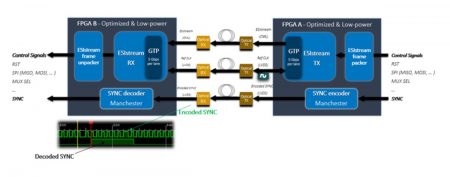Teledyne pushes for optical for remote RF heads
Teledyne e2v has demonstrated a prototype optical link that the company believes could replace the conventional electrical signaling currently used to relay the output from a remote A/D converter to the rest of the system.
Teledyne sees the growing use of beamforming in radio communications at microwave frequencies as instrumental in driving the need for a shift from electrical to optical. The current standard in use for many of these systems is the Jedec JESD204 interface and Teledyne also offers its own ESIstream protocol as an electrical alternative.
“Our optical data-link research marks a moment in time when the radio’s front-end can finally be decoupled from the advanced backend digital data processing of software defined radios. In so doing, designers gain implementation flexibility, enhanced digital beam forming capabilities and several extra design freedoms,” said Nicolas Chantier, strategic marketing director at the e2v subsidiary.
Image Block diagram of the demonstrator using Manchester encoding for the sync signal
A key element of the work that will be vital for multibeam communications is support for data synchronization. One advantage of using optical carriers is that although the electrical-optical conversion implies some latency, there is less timing variation across channels that need to be synchronized, though there is still the challenge of how to pass the sync signal. The team at e2v has carried over the use of a sync signal developed for electrical systems, and used Manchester encoding based on a reference clock to generate it.
After simulating the technique, the team built a prototype that used Xilinx Artix 7 FPGAs to perform the necessary data encoding and decoding. Though it was not able to run at the full 12.8GHz rate, the prototype did demonstrate successful transmission and synchronization at 9GHz.
In a white paper describing the current proof of concept, the e2v researchers wrote: “Once link synchronization is established, the prototype runs non-stop without loss of link locking or change in bit-error rate (BER). Better still, the Radiall optical transceivers provide digital control of the optical modulation current. This permits further tweaking of optical transmission characteristics. This should ensure, that with some further optimization, that the data transmission eye can be enlarged to allow full rate transport at 12.8 Gbps soon.”
The company plans several updates throughout this and next year as the project progresses.
